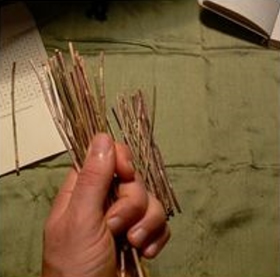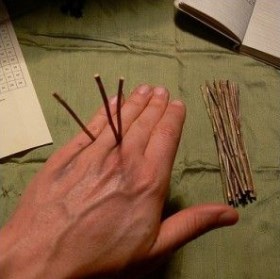ARTICLE

Chi is expressed as two structuring and polar principles, yin and yang, as they are represented in I Ching cycles and the bigrams for Heaven, Men and Earth.
According to comments attributed to Confucio, I Ching (The Book of Changes) is the world's most ancient book because its basic structure might have been developed in prehistoric times, also setting the organization implemented by ancient Chinese sovereigns, before the XXIst c. b.C.
Around 2200 b.C., in the Age of Xia Dynasty (the first one), fortune-telling was performed by cracking turtle's shells with a red hot iron (escapulomancy). The technique produced heat emissions, so cracks displayed chi as a revealing surface. To read the markings, the performers drew pictograms based on a system derived from Fu Hsi's trigrams, although there were no common rules to organize the readings, so the performers were free to understand the marks in their own ways.

Later, another method was used: 50 yarrow stalks. The lenght, straightness, durability and lightness of dried stems make them especially good for handling. And, as it happens in fortune-telling, they're used as a receptive tool to the context of irradiations, chi's flows in all beings and things, intentionally perceived by who's asking the oracle (the performer, the other receptive tool).
Using stems require making math calculations, which represent the cosmic characteristics of a year (return) by referring to the Moon, its phases, and the interspersed time.
A reading begins by separating one stem from the group, so 49 stems remain apart, as there are 49 Moon's phases, plus a fraction. The separated stem represents that fraction, and the remaining 49 ones represent the whole group of lunar phases.
The remaining 49 stems are gathered in groups of 4, because 4 stems represent a complete lunation. The remanent after forming groups symbolizes the interspersed time, "the time out of time": it's fortune-telling's time, during which we go back to zero point because linearity in the matter of interest is no more. It's a way to symbolize that fortune-telling is a new beginning that allows a restart, letting play chance as stalks are grouped again and again according to the chi in the situation.
Steps for handling stems

Separate one of the 50 rods and leave it aside. Group the remaining 49 stems and divide them into two similar groups. Place one of them on the right, and the other one on the left.

The left hand takes one of the stems in the group on the right, and places it in between the pinky and ring fingers. Later, the right hand groups 4 stems on the left side until 4 stems or less are left as rests. These ones are placed in between the ring and middle fingers in the left hand.

Similarly, 4-stem groups are separated on the right side, until 4 or less remain as rests. The remanent is placed in between the middle and index fingers in the left hand.

Count all of the stems in the left hand (3 groups in between the fingers). The result may be 9 or 5. Write it down and place the groups aside. This is the first stems' counting.
Repeat the process since the beginning, two more times. During repetitions, each result may equal 8 or 4.
The results are transformed two times. The first stem placed in between the pinky and ring fingers should not be taken into account. 9 becomes 8, and 5 becomes 4; then, 8 becomes 2, and 4 becomes 3.

Sum the results of the three countings. There will be 4 possibilities: 9, 6, 7 or 8. This is the final result, the first line of the hexagram. Only old lines change (6 and 9), whereas the young ones rest (7 and 8).
Repeat all of the previous steps 5 more times to get the other five lines of the hexagram.
Fu Hsi
He invented the calendar in Ancient Chine, introduced writing and social organization, and provided the 8 trigrams, after observing heavenly and earrhly phenomena.
Yang (heat, expansive) is represented by Chien (heaven)
Yin (cold, contracted) is represented by Kun (earth)
Chi (vital energy) is represented by Chen (thunder)
Chi's fluctuations produce the 5 elements, and all things come up from their interactions
Metal in Tui (lake, ☱) and Chien (heaven, ☰)
Water in K'an (abyss, ☵)
Wood in Sun (wind, ☴) and Chen (thunder, ☳)
Fire in Li (flame, ☲)
Earth in Ken (mountain, ☶) and Kun (earth, ☷)

After Fu Hsi, King Wen of Chou Dynasty wrote his own sequence of signs in the XIIth c. b.C. and added descriptions to the 64 hexagrams considered as paired signs, which allowed a better representation of the rhythmic structure of an always elusive and changing present. His son Tan, the famous Duke of Chou, wrote the judgments we know for each line nowadays.
Sources: IKching (removed webpage), Oráculos chinos: 7 históricos sistemas de adivinación orientales, Yi Jing: Oracle of the moon, Dinastía Xia, Rey Wen de Zhou.





Comments
Join and leave a message. I always answer personally, and as soon as possible.